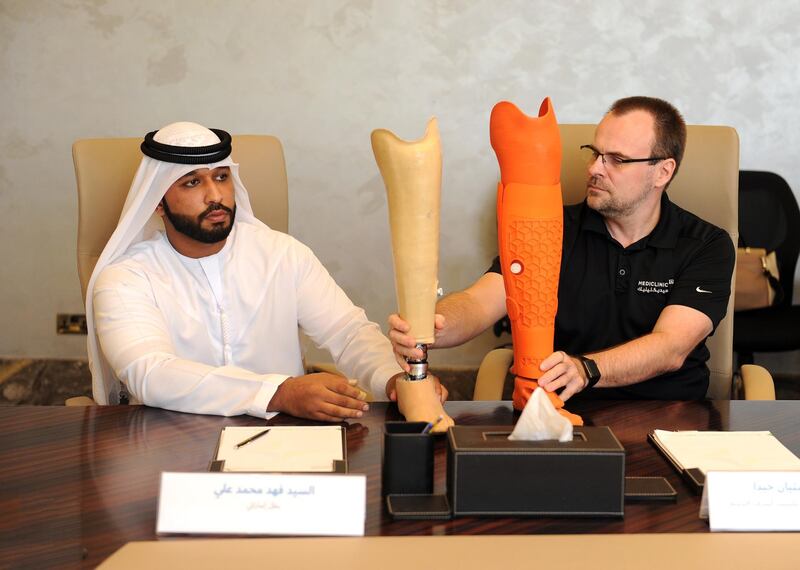The quiet health-care revolution is beginning to gather momentum in Dubai as a second patient has benefited from custom-built 3D printed legs.
Champion Emirati wheelchair racer Fahad Ali can now walk with the maximum feeling of anatomical function thanks to his new 3D prosthetics.
Mr Ali, 25, an engineer in Dubai with Dewa, has been wearing prosthetic legs for about 15 years.
On his old prosthetic limbs, Mr Ali was limping, but now walks much more freely with his new perfectly fitted legs, thanks to a partnership with Dubai Heath Authority and the private health-care sector.
“My life has been transformed,” he said.
“The 3D prosthetics make me feel like I’ve got my legs back, it’s simply incredible. I can do more sports, and wear shorts without people staring at me.
“People are interested and want to know more about what they are, they are intrigued.
“I’m more confident, it doesn’t look like I’m disabled. The difference is like night and day.”
The first 3D template printed in Dubai two years ago was a cast for a hand. And the first prosthetic printed for a patient was a leg for British expat Belinda Gatland who lost her leg in a horse-riding accident.
Belinda was the first amputee in the region to wear a completely 3D printed prosthetic leg as part of the DHA's Year of Giving initiative in 2017.
3D printing is being used beyond the sphere of prosthetics in health care, with skin, pharmaceuticals and even replacement organs and human tissue using stem cells now within the realms of possibility.
The technique is performed by programming a computer to apply layers of materials, usually plastic, metal powders or stem cells, on top of another until a mould of a final product is created.
Medical technology can build tiny organs using the same techniques to create "organoids" that can grow inside the body of a sick patient to take over when an organic organ fails.
Sebastian Giede, certified orthopaedic prosthetist with Mediclinic, that has partnered with the DHA along with Mercuris and Immensa Technology Labs, to develop the 3D printing programme.
“The potential of 3D printing in the field of prosthetic devices is huge,” he said.
“It allows faster turnaround times, with a foot customised within two to three weeks.
“It provides more personalisation in terms of design, as well as great flexibility when it comes to replacement.
“Functionality is superior by allowing us to design completely individualised models, compared to mass-manufactured prosthetics.”
__________________
Read more:
Amputee horse rider gets first 3D-printed prosthetic leg in UAE
3-D printing revolutionising the medical industry, say experts
Prospect of printing medicines at home
__________________
The patient’s measurements are entered into the computer and a 3D scan is created of the anatomy. Doctors then press the button and build the leg.
Experts would not say if 3D printing was a cheaper option than using regular prosthetics, but said it would be available to patients in Dubai who fit certain criteria.
"Our bodies change, so every four to five years new fittings are required," Mr Giede said.
“It is much quicker with the 3D printing process and we can make minute alterations during the design process to make the limbs more comfortable and efficient.
“Prosthetics are no longer a product out of the box, and can be tailored to the individual’s exact needs.”
Turnaround time for measurements and fitting is two to three weeks, rather than the two to three months required for standard prosthetic limbs.
Once a patient’s anatomical data is stored, it is easy to develop a replacement limb when needed, doctors said.
“When I saw Mr Ali's case, I thought he was a person we could help,” said Dr Mohammad Al Redha, director of the executive office for organisational transformation at the DHA.
“It is not easy to explain 3D printing in one meeting, so we met a few times to show what we could do.
“He came up with this design using the technology, so it is very personal to him.
“Once fitted, Mr Ali's said he could feel his toes, and that gave me goosebumps.
“The design allows the feet to slide, so it gives him the sensation of having his legs back.
“The technology is developing all the time, and we would like to use it more widely in Dubai on others who may benefit from this technique.”







